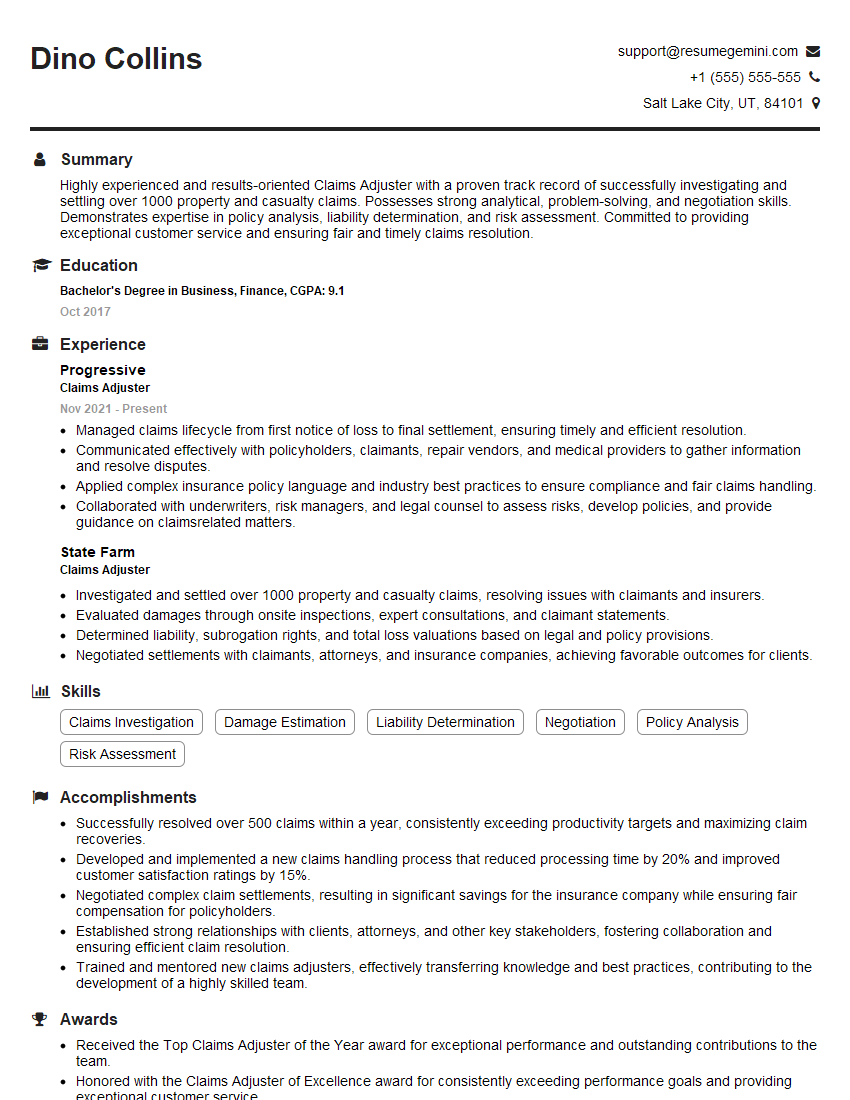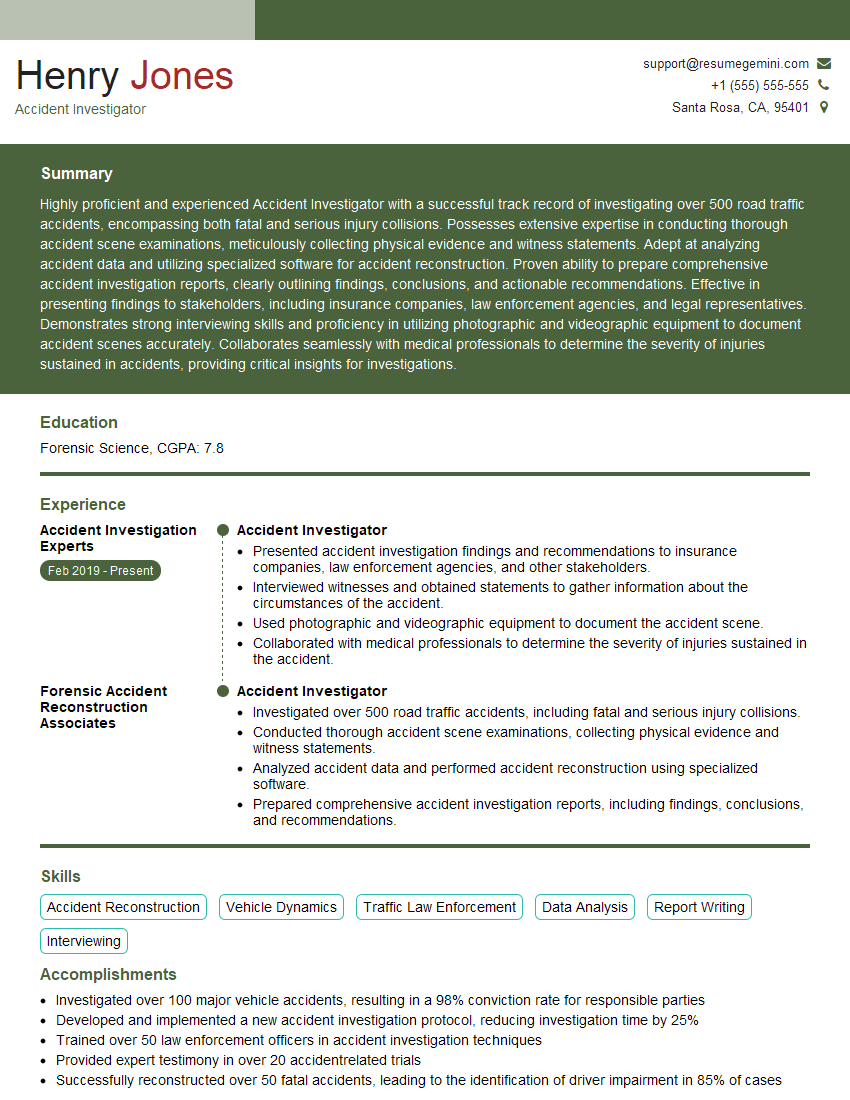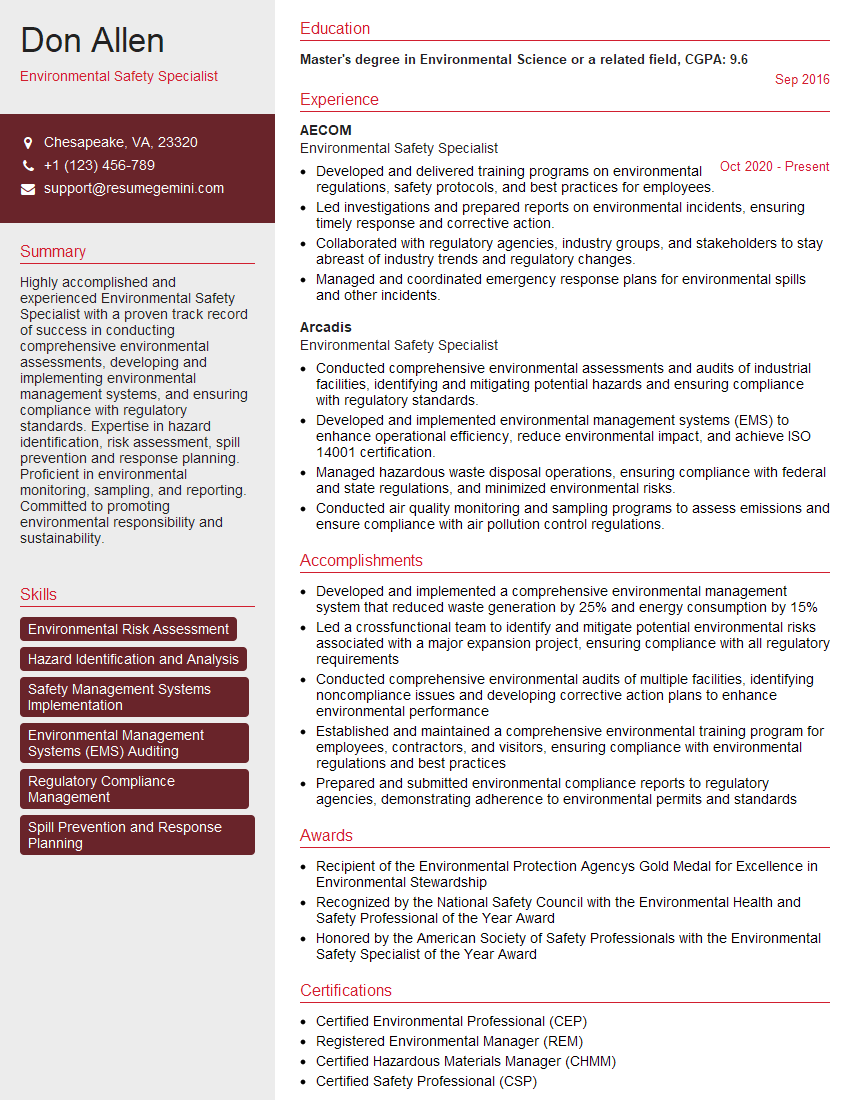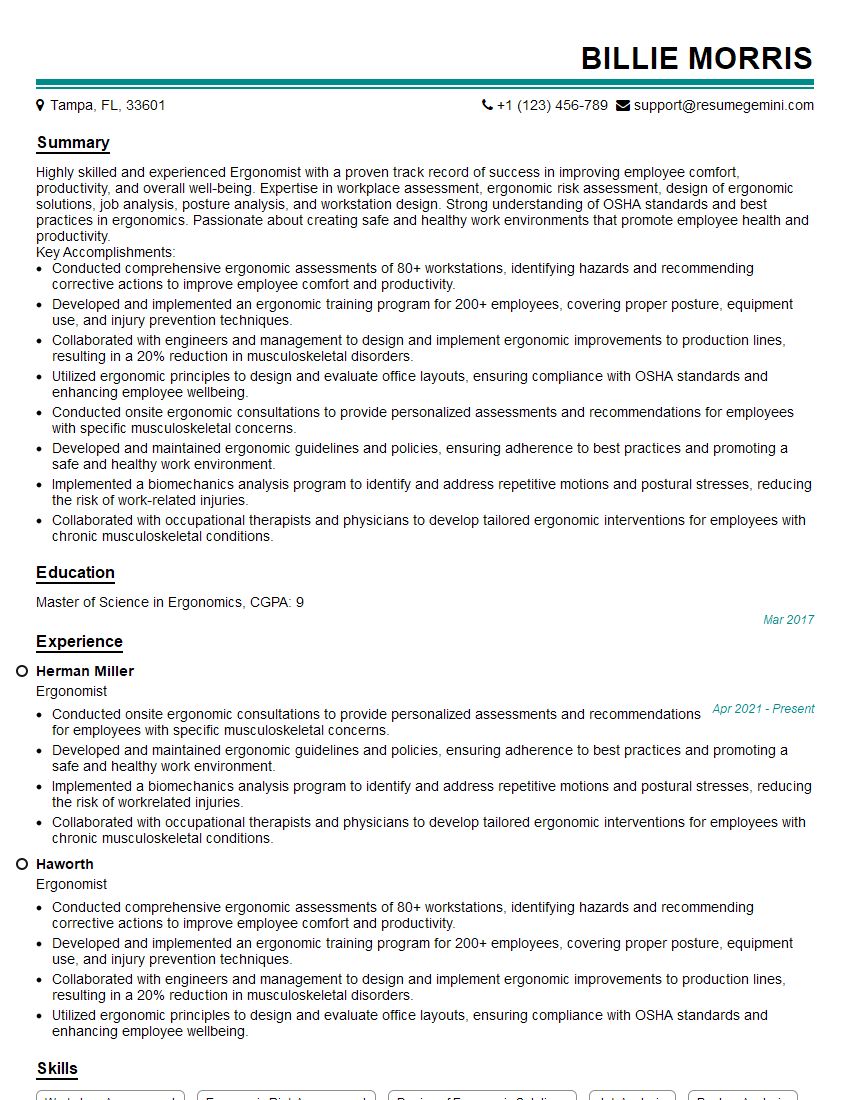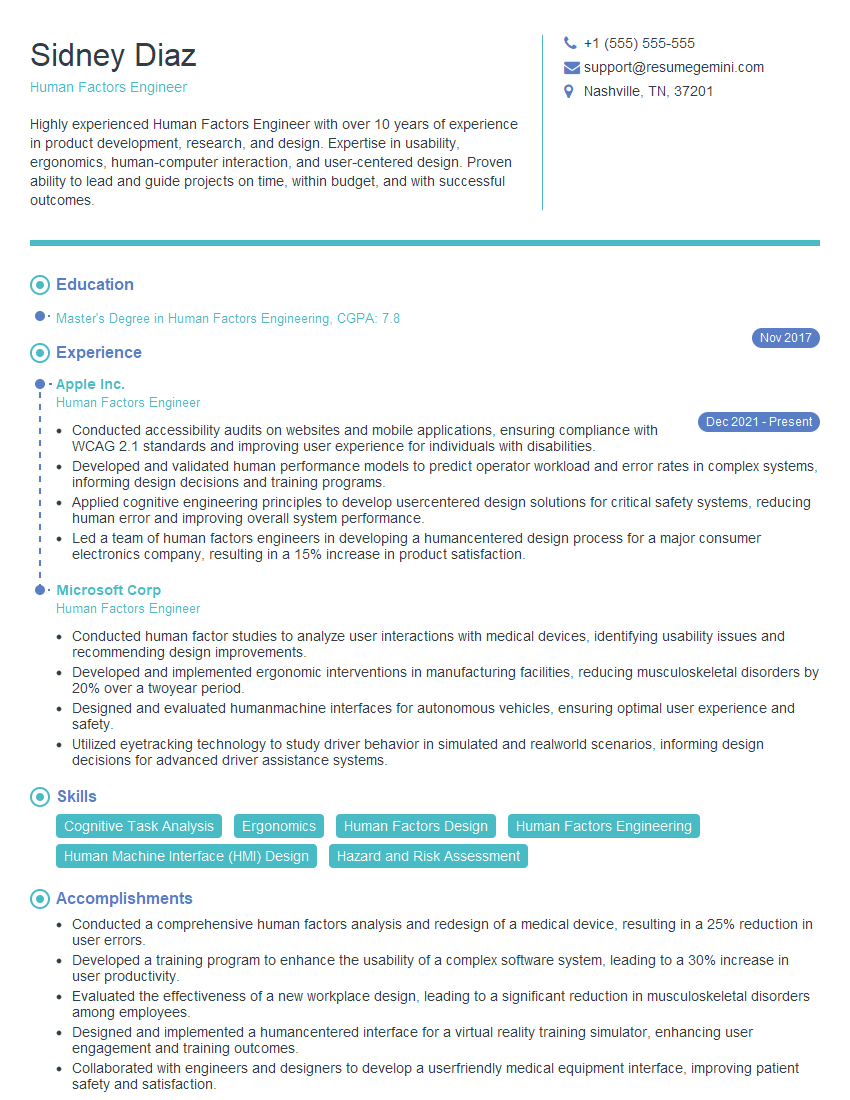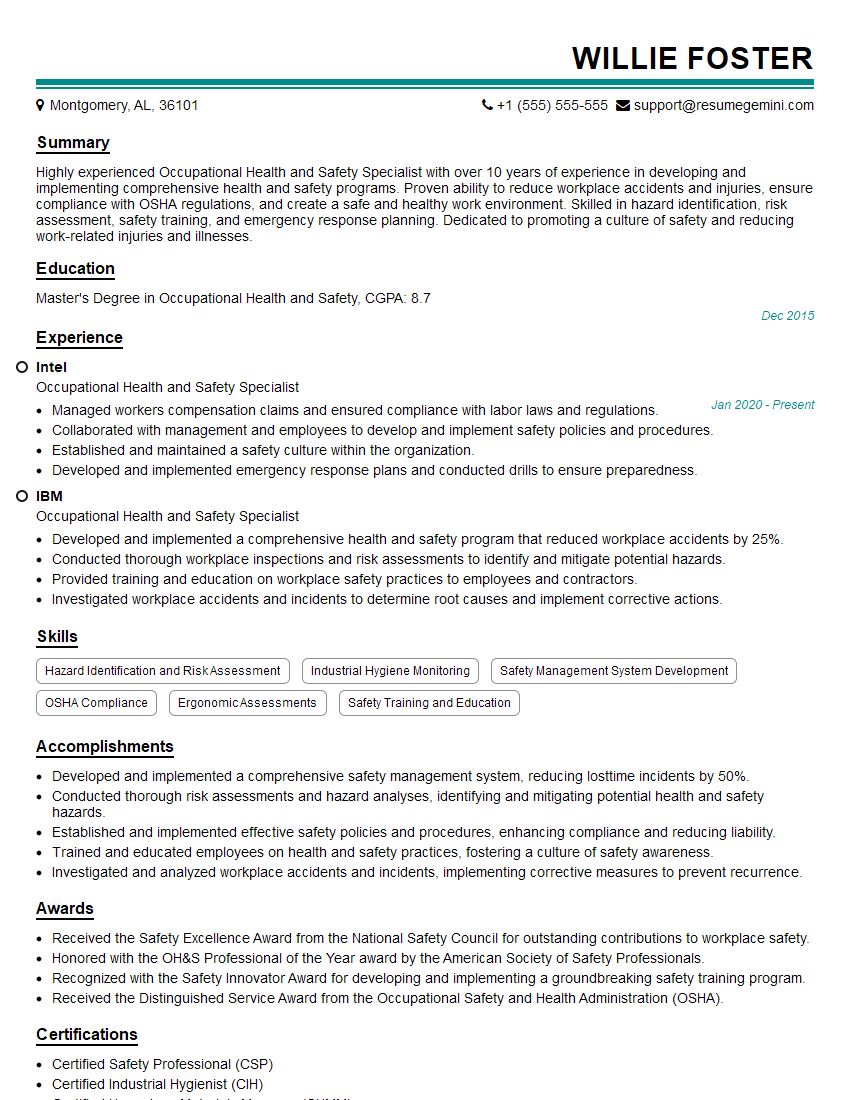Cracking a skill-specific interview, like one for Accident Analysis and Mitigation, requires understanding the nuances of the role. In this blog, we present the questions you’re most likely to encounter, along with insights into how to answer them effectively. Let’s ensure you’re ready to make a strong impression.
Questions Asked in Accident Analysis and Mitigation Interview
Q 1. Describe your experience with various accident investigation methodologies (e.g., FTA, FMEA, Bow-Tie analysis).
Throughout my career, I’ve extensively utilized various accident investigation methodologies to pinpoint the root causes of incidents and implement effective preventative measures. These include Fault Tree Analysis (FTA), Failure Mode and Effects Analysis (FMEA), and Bow-Tie analysis. Each offers a unique perspective and is best suited for different situations.
Fault Tree Analysis (FTA) is a deductive, top-down approach that starts with an undesired event (the top event) and works backward to identify the contributing causes. It’s particularly useful for complex systems where multiple failures can lead to a catastrophic outcome. For example, in analyzing a plane crash, the top event might be ‘Loss of Aircraft Control’. The FTA would then systematically explore all potential causes – from mechanical failures to pilot error – using Boolean logic (AND, OR gates) to illustrate the relationships between them. This creates a visual representation of the accident’s causal chain, aiding in identifying critical failure points.
Failure Mode and Effects Analysis (FMEA) is a proactive technique used to identify potential failure modes within a system before they occur. It involves systematically reviewing each component or process, identifying potential failures, their effects, and the severity of those effects. A severity, occurrence, and detection rating system is often employed to prioritize risks. For instance, in a manufacturing plant, an FMEA might be conducted on an assembly line to assess the risk of component malfunctions, their impact on product quality, and the likelihood of detection. This allows for preventative actions to be taken before a failure leads to an accident.
Bow-Tie analysis combines elements of FTA and risk assessment. It visually represents the hazards (the ‘threat’), the preventative controls (the ‘left-hand side’), and the consequences (the ‘right-hand side’), along with mitigative controls. This holistic approach is highly effective in identifying both proactive and reactive measures to manage risks. For example, in a chemical plant, the ‘threat’ might be a chemical leak, the preventative controls could be regular equipment maintenance and safety protocols, and the mitigative controls might include emergency response plans and containment systems.
Q 2. Explain the difference between proactive and reactive safety measures.
The difference between proactive and reactive safety measures lies in their timing and focus. Reactive safety measures are implemented *after* an accident or near-miss has occurred. They address the immediate consequences and aim to prevent a recurrence of the *specific* incident. For example, after a worker sustains a hand injury while operating a machine, adding a safety guard to the machine would be a reactive measure.
Proactive safety measures, on the other hand, are implemented *before* an accident occurs. They anticipate potential hazards and aim to prevent accidents from happening in the first place. Regular safety inspections, employee training programs, and the implementation of robust safety systems are examples of proactive measures. A comprehensive safety management system heavily emphasizes proactive measures, reducing the likelihood of accidents and minimizing their impact.
Think of it like this: reactive measures are like patching a hole in a dam after a leak; proactive measures are like building the dam strong enough to withstand floods. A balanced approach encompassing both proactive and reactive measures is ideal for a robust safety program.
Q 3. How do you identify and prioritize hazards in a workplace?
Hazard identification and prioritization is a critical aspect of accident prevention. It involves a systematic process to identify potential hazards in the workplace, assess their risks, and then prioritize them based on the level of risk. This often involves a combination of techniques.
- Hazard identification techniques: These include workplace inspections, job safety analyses, checklists, hazard and operability studies (HAZOP), brainstorming sessions, and incident/near-miss reporting.
- Risk assessment: Once hazards are identified, a risk assessment needs to be performed. This typically involves estimating the likelihood of the hazard occurring (probability) and the severity of the potential consequences (impact). This can often be expressed qualitatively (e.g., low, medium, high) or quantitatively (e.g., using numerical scales).
- Prioritization: Risks are prioritized based on their overall risk level, which is usually a product of probability and severity. Matrices (like risk matrices) are often used to visualize the risk level and to easily prioritize hazards. High-risk hazards are addressed first, often through implementing control measures.
For example, in a construction site, a hazard identification process might identify unsafe scaffolding as a high-risk hazard. The risk assessment might determine a high likelihood of a fall and the severity of the consequence being potentially fatal. Consequently, this would be prioritized for immediate corrective actions like scaffolding inspection and reinforcement.
Q 4. What are the key elements of a comprehensive safety management system?
A comprehensive safety management system (SMS) is a holistic approach to managing safety risks and promoting a positive safety culture within an organization. Key elements include:
- Leadership commitment: Strong leadership support and commitment are crucial for the effectiveness of any SMS. Leaders must demonstrate a genuine commitment to safety and allocate the necessary resources.
- Risk assessment and management: A robust system for identifying, assessing, and managing risks is fundamental. This involves hazard identification, risk analysis, risk control, and monitoring.
- Safety policy and procedures: Clear, concise, and well-communicated safety policies and procedures are necessary to guide actions and ensure consistent implementation of safety measures.
- Training and competency: Regular and appropriate training is essential to ensure all personnel are competent to perform their tasks safely.
- Emergency preparedness and response: Having well-defined emergency plans and procedures is critical to minimize the impact of accidents and incidents. Regular drills and simulations are important.
- Monitoring and review: The SMS needs to be continuously monitored and reviewed to ensure its effectiveness. This includes incident investigations, audits, and management reviews. Data analysis is crucial for making informed decisions.
- Communication and consultation: Effective communication is vital throughout the SMS. Regular communication channels should be in place to share information, feedback, and concerns.
A well-implemented SMS fosters a safety culture where safety is everyone’s responsibility and proactively manages risks, reducing the likelihood and impact of accidents.
Q 5. Describe your experience with root cause analysis techniques.
Root cause analysis (RCA) is a critical process in accident investigation to identify the underlying causes of incidents, going beyond just the immediate causes. Several techniques exist, each with its strengths and weaknesses.
5 Whys: This is a simple, iterative questioning technique where you repeatedly ask ‘Why?’ to progressively drill down to the root cause. While straightforward, it can sometimes miss complex or systemic causes. For instance, if a car accident occurred due to brake failure, asking ‘Why?’ repeatedly might reveal issues with maintenance, inadequate training, and finally, a lack of management oversight.
Fishbone Diagram (Ishikawa Diagram): This visual tool helps to brainstorm various potential causes categorized into key areas (e.g., people, machines, methods, materials, environment). It encourages a more comprehensive approach than the 5 Whys.
Fault Tree Analysis (FTA): As described earlier, FTA provides a more rigorous approach for complex systems. Its deductive process helps systematically uncover the root causes by exploring various failure scenarios.
Taproot Analysis: This technique combines several approaches and delves into the underlying organizational factors that contributed to the accident. It addresses both immediate causes and latent organizational failures.
My experience encompasses all these methods. The choice of technique depends on the complexity of the accident and the desired level of detail in the investigation. Often, a combination of methods is employed to gain a thorough understanding.
Q 6. How do you develop and implement corrective actions to prevent future accidents?
Developing and implementing corrective actions is crucial to preventing future accidents. This process usually involves several steps:
- Identify corrective actions: Based on the RCA findings, identify specific actions needed to eliminate or mitigate the root causes. These actions should address both immediate and underlying issues.
- Prioritize corrective actions: Prioritize actions based on their effectiveness, feasibility, and urgency. High-impact, easily implemented actions should be addressed first.
- Assign responsibility and timelines: Clearly assign responsibility for each corrective action and set realistic timelines for implementation.
- Implement corrective actions: Execute the planned actions meticulously and ensure proper documentation.
- Verify effectiveness: After implementation, verify the effectiveness of the corrective actions through monitoring and evaluation. This might involve further inspections, audits, or data analysis to confirm whether the actions achieved the desired outcomes.
- Document and communicate: All corrective actions, their implementation, and verification results should be thoroughly documented. This information needs to be communicated effectively to relevant stakeholders.
For example, if an RCA of a near-miss identified inadequate worker training as a root cause, corrective actions might include developing and delivering updated training materials, scheduling refresher courses, and implementing a competency assessment program. The effectiveness of these actions would then be monitored by tracking near-miss rates and employee feedback.
Q 7. Explain your understanding of human factors contributing to accidents.
Human factors play a significant role in many accidents. These are elements relating to human behavior, physiology, and psychology that can influence the likelihood of errors and accidents. A deep understanding of these factors is essential in accident analysis and prevention.
Examples of human factors include:
- Cognitive factors: Decision-making processes, attention span, perception, memory, and workload. For example, fatigue can impair judgment and reaction time, leading to errors.
- Physical factors: Physical limitations, strength, dexterity, and endurance. For example, a worker’s physical limitations might make them more vulnerable to musculoskeletal injuries.
- Organizational factors: Management systems, organizational culture, communication, training, and supervision. For instance, a lack of clear safety procedures or inadequate training can significantly increase the risk of accidents.
- Environmental factors: Noise, lighting, temperature, and other environmental conditions that can affect human performance. Extreme temperatures or poor lighting can increase the likelihood of errors.
- Human error: Mistakes, slips, lapses, violations – these can be attributed to a variety of cognitive, physical, and organizational factors. Analyzing human error requires understanding both the individual and the system that contributed to the error.
By carefully investigating human factors, accident investigators can identify underlying systemic issues contributing to human error and develop interventions to improve safety performance. This includes things like improved training, redesigning work processes, and fostering a safety-conscious organizational culture.
Q 8. How do you conduct a thorough accident investigation?
A thorough accident investigation follows a systematic process to determine the root cause, contributing factors, and preventive measures. Think of it like solving a complex puzzle – you need to gather all the pieces before you can see the complete picture.
- Immediate Response and Scene Preservation: The first step is securing the scene, ensuring the safety of everyone involved, and preventing further damage or loss of evidence. This involves documenting the scene with photographs, videos, and sketches.
- Data Collection: This involves gathering information from various sources such as witness testimonies, physical evidence, equipment logs, safety records, and relevant documentation. We use techniques like interviewing witnesses using open-ended questions to avoid bias, and analyzing physical evidence to pinpoint mechanical failures or human error.
- Analysis and Root Cause Determination: This is where we use various analytical tools such as fault tree analysis (FTA) or the ‘5 Whys’ technique to systematically delve into the chain of events leading to the accident. For instance, if a worker fell from a ladder, the ‘5 Whys’ might reveal that the fall was due to a broken rung, which was due to lack of regular inspection, which was due to insufficient training, and so on.
- Report Writing and Recommendations: The findings are compiled into a comprehensive report, detailing the root causes, contributing factors, and recommendations for corrective and preventive actions. The report needs to be clear, concise, and actionable.
For example, in investigating a car accident, we would analyze the vehicle damage, road conditions, witness statements, and driver’s records to determine if the accident was due to speeding, driver impairment, mechanical failure, or road hazards.
Q 9. What are the legal and regulatory requirements related to accident reporting?
Legal and regulatory requirements related to accident reporting vary depending on the industry, location, and severity of the accident. However, there are common threads. Generally, serious accidents must be reported to relevant authorities such as OSHA (Occupational Safety and Health Administration) in the US or equivalent agencies in other countries within a specified timeframe.
These reports typically include details of the accident, the injuries sustained, the contributing factors, and any corrective actions taken. Failure to comply can result in significant penalties, including fines, legal action, and damage to reputation.
For example, in the aviation industry, accident reporting is governed by stringent international regulations, requiring immediate notification to air accident investigation agencies and detailed reporting encompassing various aspects of the incident.
Similarly, in the healthcare sector, incidents involving patient harm must be meticulously documented and reported, often involving internal investigations and external regulatory scrutiny. The exact requirements and reporting procedures are usually detailed in specific legislation and industry-specific codes of practice.
Q 10. How do you communicate accident investigation findings to stakeholders?
Communicating accident investigation findings effectively is crucial for preventing future incidents. The audience greatly influences how we communicate.
- Internal Stakeholders: For internal teams, a detailed report with technical analysis and recommendations for improvement is necessary. We may use presentations, workshops, and training sessions to explain the findings and ensure everyone understands the implications.
- External Stakeholders: For external stakeholders, such as regulatory bodies or the public, the communication needs to be clear, concise, and accessible, focusing on the key findings and preventive measures. Press releases or public statements may be necessary, depending on the nature of the incident and public interest.
Regardless of the audience, the communication should be factual, transparent, and avoid placing blame. The focus should be on learning from the event and implementing strategies to prevent recurrence.
Visual aids like charts, graphs, and flowcharts can significantly improve understanding and engagement. Involving relevant stakeholders in the investigation and communication process can improve trust and support for implementing recommendations.
Q 11. Describe your experience with risk assessment and mitigation strategies.
Risk assessment is the process of identifying hazards, analyzing their potential risks, and determining appropriate control measures. Mitigation strategies then aim to reduce or eliminate those risks.
My experience involves utilizing various risk assessment methodologies, such as HAZOP (Hazard and Operability Study) and FMEA (Failure Mode and Effects Analysis). I’ve applied these in diverse settings, from construction sites to manufacturing plants. For instance, in a construction project, a HAZOP study might identify the risk of a crane collapse. Mitigation strategies could include regular crane inspections, operator training, and appropriate load limits.
The process typically involves:
- Hazard Identification: Listing potential hazards through brainstorming, checklists, and historical data.
- Risk Analysis: Assessing the likelihood and severity of each hazard, often using a risk matrix.
- Risk Evaluation: Prioritizing hazards based on their risk level (likelihood x severity).
- Mitigation Strategies: Implementing control measures such as engineering controls (e.g., safety guards), administrative controls (e.g., training programs), and personal protective equipment (PPE).
- Monitoring and Review: Regularly reviewing the effectiveness of the controls and making adjustments as needed.
Effective risk mitigation is a continuous process, not a one-time event.
Q 12. What safety standards and regulations are you familiar with?
I’m familiar with a wide range of safety standards and regulations, including:
- OSHA (Occupational Safety and Health Administration) standards: These cover various aspects of workplace safety, including fall protection, hazard communication, and machine guarding.
- ANSI (American National Standards Institute) standards: These provide guidelines for various industries, including safety equipment and practices.
- ISO (International Organization for Standardization) standards: These are internationally recognized standards related to quality management, environmental management, and occupational health and safety.
- NFPA (National Fire Protection Association) standards: These cover fire safety codes and practices.
My familiarity extends to industry-specific standards and regulations, adapting my knowledge to the specific context of each situation. Staying up-to-date on the latest regulations is crucial in this field.
Q 13. How do you use data analysis to identify accident trends?
Data analysis plays a crucial role in identifying accident trends. By collecting and analyzing data from various sources, we can identify patterns and contributing factors. This involves using statistical methods and data visualization techniques.
For example, we might analyze accident reports to identify common causes, such as equipment failures or human errors. We might also look at the time of day, location, and environmental conditions to identify contributing factors. This data can be visualized using charts and graphs to highlight trends and patterns.
Techniques like:
- Descriptive Statistics: Calculating means, medians, and standard deviations to summarize the data.
- Regression Analysis: Identifying correlations between variables, such as the relationship between workload and accident frequency.
- Data Mining: Using sophisticated algorithms to uncover hidden patterns and relationships in large datasets.
This data-driven approach helps to focus preventative efforts on the most significant contributors to accidents.
Q 14. How do you ensure the accuracy and reliability of accident investigation data?
Ensuring the accuracy and reliability of accident investigation data is paramount. This involves:
- Data Validation: Verifying the accuracy and completeness of data collected from different sources, cross-referencing information where possible.
- Data Triangulation: Using multiple data sources to corroborate findings. If multiple witnesses describe the same sequence of events, it increases the reliability of the account.
- Chain of Custody: Maintaining a detailed record of the handling and storage of physical evidence to ensure its integrity.
- Objective Data Collection: Using structured data collection methods, such as standardized forms and checklists, to minimize bias. Interviewing techniques should also be carefully selected to avoid leading questions and elicit unbiased responses.
- Peer Review: Having the investigation findings reviewed by other experts to identify any potential errors or biases.
By employing rigorous data collection and analysis techniques, we minimize error and maximize the validity of our findings and subsequent recommendations.
Q 15. What are the ethical considerations in accident investigation?
Ethical considerations in accident investigation are paramount. They ensure fairness, objectivity, and the pursuit of truth, not blame. We must maintain confidentiality, protecting the privacy of individuals involved. For instance, personal medical information should only be accessed if absolutely necessary and with appropriate authorization. Objectivity is crucial; we must avoid bias and pre-conceived notions, focusing solely on factual data and evidence. We have a responsibility to present findings transparently and honestly, even if it’s uncomfortable or reflects poorly on any party. Consider a workplace accident – we might uncover systemic safety failures rather than just individual negligence. Our duty is to report these findings openly to prevent future incidents, even if it means pointing out deficiencies within the organization. Finally, we must comply with all relevant legal and regulatory frameworks, such as data protection laws and reporting requirements.
Career Expert Tips:
- Ace those interviews! Prepare effectively by reviewing the Top 50 Most Common Interview Questions on ResumeGemini.
- Navigate your job search with confidence! Explore a wide range of Career Tips on ResumeGemini. Learn about common challenges and recommendations to overcome them.
- Craft the perfect resume! Master the Art of Resume Writing with ResumeGemini’s guide. Showcase your unique qualifications and achievements effectively.
- Don’t miss out on holiday savings! Build your dream resume with ResumeGemini’s ATS optimized templates.
Q 16. Explain your experience with incident reporting systems.
Throughout my career, I’ve worked extensively with various incident reporting systems, from simple spreadsheet-based methods to sophisticated, integrated software platforms. Early in my career, I used basic databases to track workplace injuries, meticulously recording details like date, time, location, nature of the injury, and contributing factors. This involved manually inputting data, which was time-consuming but taught me the importance of precise data collection. In later roles, I transitioned to more advanced systems that allowed for automated data capture, real-time reporting dashboards, and integrated safety management tools. One system I used extensively incorporated GPS tracking, allowing for precise mapping of incidents, and integrated directly with our company’s risk management software. This enabled a more proactive approach to accident prevention, allowing us to quickly identify high-risk areas and implement corrective actions. The advantages of these systems include improved data analysis capabilities, enhanced trend identification, and more efficient reporting to regulatory bodies.
Q 17. How do you manage conflicting information during an accident investigation?
Conflicting information is a common challenge in accident investigations. Managing it effectively requires a systematic approach. First, I meticulously document all statements and evidence, regardless of whether they align. I use a variety of techniques, including recording interviews and taking detailed notes. Next, I carefully evaluate the credibility of sources. This involves considering factors such as the witness’s proximity to the event, their emotional state, and any potential biases. Triangulation is crucial; I seek corroborating evidence to support or refute the conflicting claims. For example, physical evidence like damage to equipment or CCTV footage can often provide objective validation. If discrepancies remain, I acknowledge them clearly in the final report, emphasizing areas of uncertainty and the limitations of the investigation. Transparency is key—it’s better to acknowledge inconsistencies than to attempt to artificially resolve conflicts.
Q 18. How do you determine the causal factors of an accident?
Determining causal factors often involves employing a multi-faceted approach. I typically start with a detailed reconstruction of the event, using witness statements, physical evidence, and any available data. I then use various analytical tools, such as fault tree analysis and event tree analysis (discussed later), to systematically identify the contributing factors. These tools help visualize the chain of events leading to the accident, revealing underlying causes beyond immediate superficial observations. For example, a seemingly simple slip-and-fall accident might be traced back to inadequate floor maintenance, inadequate training in safe working practices, and ultimately a failure in management oversight. It’s important to consider ‘root causes’—the underlying reasons why the contributing factors were present in the first place, leading to a comprehensive understanding and effective preventive measures.
Q 19. Describe your experience with different types of accident data (e.g., quantitative, qualitative).
My experience encompasses both quantitative and qualitative accident data. Quantitative data involves numerical measurements, such as the speed of a vehicle in a collision or the number of injuries sustained. This type of data allows for statistical analysis, revealing patterns and trends. Qualitative data is descriptive and includes witness accounts, interview transcripts, and observational notes. This enriches our understanding of the human factors involved, providing context and depth. For instance, in a chemical spill investigation, quantitative data might include the volume of the spilled substance and its concentration. Qualitative data, however, would include descriptions of the procedures followed, the workers’ training, and their perceptions of safety protocols. Both are essential—quantifiable data provides a factual baseline, while qualitative data offers the context for meaningful interpretation and effective recommendations.
Q 20. How do you validate your findings in an accident investigation?
Validating findings is crucial for the credibility and utility of any accident investigation. This involves several steps. First, peer review is essential; presenting our findings to other experts in the field allows for independent scrutiny and challenge. Second, we cross-reference our conclusions against different data sources; consistency across various forms of evidence strengthens our claims. Third, we ensure our methodology is robust and transparently documented, allowing others to replicate our investigation. Fourth, we examine our findings for any potential biases or limitations; acknowledging these enhances credibility. Finally, we incorporate feedback from the review process and address any raised concerns, leading to a more reliable and accurate final report.
Q 21. How do you use different types of diagrams (e.g., fault trees, event trees) in accident analysis?
Diagrams are powerful tools in accident analysis. Fault tree analysis (FTA) is a top-down, deductive approach that identifies potential causes contributing to a specific undesired event (the ‘top event’). It’s like a reverse engineering process, working backward from the accident to uncover its root causes. Event tree analysis (ETA) is a bottom-up, inductive approach that starts with an initiating event and traces its potential consequences through different scenarios. It helps explore the probabilities of different outcomes. For example, in a fire investigation, an FTA might start with ‘building fire’ as the top event and branch down to explore causes like faulty wiring, flammable materials, or lack of fire safety measures. An ETA might start with an ‘electrical fault’ and analyze the probability of it leading to a fire, considering factors like the availability of fire suppression systems and the speed of emergency response. Both methods provide a visual representation of complex causal relationships, facilitating clearer communication and enhancing our understanding of accident mechanisms.
Q 22. Explain your understanding of the principles of ergonomics and their role in accident prevention.
Ergonomics is the science of designing the workplace, equipment, and tasks to fit the people who use them. Its core principle is to minimize physical strain and maximize efficiency and comfort, directly impacting accident prevention. By adapting the work environment to human capabilities and limitations, we can significantly reduce the risk of musculoskeletal disorders (MSDs), slips, trips, and falls, and other injuries.
- Example 1: Designing a workstation with adjustable chairs, keyboard trays, and monitor height to accommodate workers of varying sizes prevents back pain, eye strain, and repetitive strain injuries.
- Example 2: Implementing proper lifting techniques and using mechanical aids for heavy loads reduces the risk of back injuries. Training employees on these techniques is critical.
In essence, a well-ergonomically designed workplace promotes worker well-being, leading to increased productivity and a significantly safer environment.
Q 23. How do you measure the effectiveness of safety interventions?
Measuring the effectiveness of safety interventions involves a multi-faceted approach. We don’t just look at accident numbers but analyze leading indicators as well. This means tracking near misses, observations of unsafe behaviors, and the completion rates of safety training, among others. Lagging indicators, like the number of accidents, are also crucial but only tell part of the story.
- Quantitative Data: This includes accident rates (frequency and severity), lost time injury rates (LTIR), near miss reporting rates, and improvements in safety scores based on audits.
- Qualitative Data: This involves conducting surveys, interviews, and focus groups to assess employee perception of safety, identifying areas for improvement, and measuring the impact of training programs. Observational data from safety inspections is also important.
We often use statistical analysis like comparing accident rates before and after an intervention, or calculating the return on investment (ROI) of safety initiatives. It’s all about demonstrating a clear and measurable improvement in safety performance.
Q 24. Describe your experience with safety audits and inspections.
My experience with safety audits and inspections spans diverse industries. I’ve conducted both planned and unplanned audits, using a structured methodology to assess compliance with regulations, identify hazards, and evaluate the effectiveness of existing safety programs.
- Methodology: A typical audit involves a pre-audit planning phase, on-site inspections using checklists and observations, interviews with employees, review of safety documentation, and finally, a report with findings and recommendations. I use a combination of leading and lagging indicators to measure performance.
- Example: During an inspection at a manufacturing facility, I identified a lack of proper machine guarding, which led to recommendations for immediate corrective action and implementation of a comprehensive machine guarding program. This included training sessions for operators on the proper use of machinery and lockout/tagout procedures.
The goal is not simply to find fault, but to collaboratively identify weaknesses and contribute to a safer workplace. I’ve been instrumental in initiating improvements to workplace safety procedures and enhancing safety cultures through thorough assessments.
Q 25. How do you develop and deliver safety training programs?
Developing and delivering effective safety training programs requires a needs assessment to identify skill gaps and tailor the content accordingly. I use a variety of teaching methods – interactive workshops, online modules, and on-the-job training – to keep participants engaged.
- Needs Assessment: This involves analyzing accident data, observing work practices, interviewing workers, and reviewing relevant regulations to determine the training needs.
- Training Design: The training is designed using adult learning principles, incorporating interactive elements, case studies, and practical exercises to reinforce learning.
- Delivery Methods: I utilize various methods, including interactive classroom sessions, computer-based training, simulations, and practical demonstrations to cater to different learning styles.
- Evaluation: Post-training evaluations, including quizzes and performance observation, help to assess the effectiveness of the training and identify areas for improvement.
For instance, I recently developed a comprehensive fall protection training program for construction workers, incorporating hands-on practice with safety equipment and scenarios. Post-training assessments showed a significant improvement in their knowledge and ability to perform the tasks safely.
Q 26. How do you ensure compliance with safety regulations?
Ensuring compliance with safety regulations is a continuous process, not a one-time event. It involves staying updated on the latest regulations, implementing control measures to comply with those regulations, conducting regular audits, and documenting all actions.
- Staying Updated: Continuous monitoring of regulatory changes and updates through industry publications, government websites, and professional organizations.
- Implementation of Controls: Development and implementation of safety procedures, training programs, and engineering controls to address identified hazards.
- Regular Audits and Inspections: Performing routine internal audits and inspections to assess compliance and identify areas for improvement.
- Documentation: Maintaining detailed records of safety training, audits, inspections, corrective actions, and other safety-related activities.
For example, I developed a system for tracking regulatory updates and compliance status, using a software solution to automate the process and ensure timely action on non-compliance issues. This proactive approach ensures our company remains ahead of regulatory requirements, minimizing the risk of penalties and improving overall safety.
Q 27. Describe your experience with emergency response planning and procedures.
My experience with emergency response planning and procedures includes developing and implementing comprehensive emergency response plans tailored to specific workplace hazards and risks. These plans cover everything from fire safety and evacuation procedures to chemical spills and medical emergencies.
- Hazard Identification: Thorough identification and analysis of potential workplace hazards, including natural disasters and man-made incidents.
- Plan Development: Creation of detailed emergency response plans, including pre-emergency preparedness, emergency response procedures, and post-emergency recovery procedures.
- Training and Drills: Conducting regular emergency response training and drills to ensure all employees know their roles and responsibilities.
- Communication Systems: Establishing clear communication systems to ensure effective communication during emergencies.
In a previous role, I developed an emergency response plan for a chemical manufacturing plant that involved detailed procedures for handling chemical spills, including containment, cleanup, and employee evacuation. We conducted regular drills, which highlighted areas for improvement and ensured the plan’s effectiveness.
Q 28. How do you evaluate the effectiveness of safety management systems?
Evaluating the effectiveness of safety management systems requires a holistic approach. It’s not just about looking at the number of accidents but also the overall safety culture, the effectiveness of safety programs, and the level of employee engagement.
- Performance Indicators: Using key performance indicators (KPIs) such as accident rates, near miss rates, and employee safety survey results.
- Audits and Inspections: Conducting internal and external audits and inspections to assess compliance with safety regulations and best practices.
- Employee Feedback: Gathering employee feedback through surveys, interviews, and focus groups to assess the effectiveness of the safety management system and identify areas for improvement.
- Continuous Improvement: Implementing a continuous improvement process based on the findings of audits, inspections, and employee feedback.
For example, a mature safety management system will not only have a low accident rate but also demonstrate a strong safety culture, active employee participation in safety initiatives, and readily available safety information. Regular review and improvement are key to long-term success.
Key Topics to Learn for Accident Analysis and Mitigation Interview
- Accident Investigation Methodologies: Understanding various investigative techniques like the 5 Whys, Fault Tree Analysis, and Fishbone diagrams. This includes practical application in different accident scenarios.
- Human Factors Analysis: Exploring the role of human error in accidents, including cognitive biases, situational awareness, and human-machine interaction. Learn to apply this understanding to identify contributing factors and recommend preventative measures.
- Risk Assessment and Management: Mastering techniques for identifying, analyzing, and mitigating risks. This includes practical application of risk matrices, HAZOP studies, and bow-tie analysis.
- Data Analysis and Statistical Methods: Gaining proficiency in using statistical tools to analyze accident data, identify trends, and support your findings. Practical application involves data visualization and interpretation.
- Accident Prevention and Mitigation Strategies: Developing strategies for preventing future accidents based on thorough analysis. This includes the implementation of safety protocols, engineering controls, and training programs. Consider real-world case studies.
- Regulatory Compliance and Reporting: Understanding relevant regulations and legal requirements for accident reporting and investigation. Knowing how to prepare comprehensive reports is crucial.
- Safety Culture and Management Systems: Understanding the importance of a strong safety culture within an organization and how to implement effective safety management systems (SMS).
Next Steps
Mastering Accident Analysis and Mitigation is crucial for career advancement in safety-critical industries, opening doors to leadership roles and specialized expertise. A strong resume is key to showcasing your skills effectively to potential employers. Creating an ATS-friendly resume is paramount to ensuring your application is seen by recruiters. To help you build a compelling and effective resume, we recommend using ResumeGemini, a trusted resource for crafting professional resumes. ResumeGemini provides examples of resumes tailored to Accident Analysis and Mitigation, guiding you through the process of highlighting your unique qualifications. Take the next step towards your dream career – build a winning resume today!
Explore more articles
Users Rating of Our Blogs
Share Your Experience
We value your feedback! Please rate our content and share your thoughts (optional).
What Readers Say About Our Blog
Hi, I represent an SEO company that specialises in getting you AI citations and higher rankings on Google. I’d like to offer you a 100% free SEO audit for your website. Would you be interested?
good


